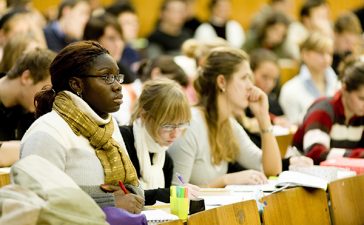Arizona State University. The University of Arkansas system. The University System of Georgia.
As spring stretches into summer, colleges keep announcing their plans to resume in-person instruction in the fall. But a few trends stick out.
Many of the institutions planning to return in the fall are four-year colleges and universities, especially those that are private. The institutions planning to stick with virtual instruction are predominantly two-year public colleges.
Several factors are influencing leaders’ decision making for the fall semester. While they vary from college to individual college, wider trends exist in each sector.
“As we got to looking at the fall semester, it was really a science and math problem,” said Joe May, president of the Dallas County Community College District.
May and other leaders of the district faced problems with scaling public health safety interventions. The college serves 162,000 students each year. When leaders looked at screening 40,000 students per day for symptoms of COVID-19, May said, they realized it wasn’t a feasible task.
“Even if we were to get this down to just 10 to 15 seconds per person as we were going through that process, that would create lines, which is also a health risk, and it would create delays to get in,” he said.
The district also has some advantages. It’s a commuter campus, as many two-year colleges are, so it isn’t losing the significant chunk of revenue from residential housing, dining services and parking fees that so many four-year institutions rely on.
“Providing an on-campus residential experience is not really part of what we are, but it’s a big part of what universities offer,” May said. “Students often choose institutions as much for on-campus life opportunities as they do academic opportunities. Their leadership is well aware of that, and they understand that’s something students are considering.”
The community college released its decision to continue teaching mostly online in the fall on May 7, even as some colleges continue to wait to make a decision.
The relatively early announcement came because the college’s answer to that question — what to do in the fall? — was fairly simple after looking at the numbers, May said. The Dallas district’s leaders also wanted to get a decision to students sooner rather than later, so they can start planning.
Dallas surveyed its students and found that about 52 percent would consider taking online classes because of the pandemic. Feedback on the survey also made the college realize that maintaining trust with students would be important.
Still, some people have questioned the decision, May said. When asked if he’s felt political pressure to reopen as Texas’s governor starts to lift restrictions on businesses, he said policy makers and state leaders have not been overly critical to his face.
“At the same time, I’m well aware of the overall climate,” he said. “Frankly, I understand that. Everybody wants to return to normalcy. What we have to weigh is that it’s not a ready, aim, fire approach. It really has to be a very thoughtful approach. It’s more than health — it really is trust. What we offer our students every day is they can trust us to provide a quality education at a reasonable cost, and they don’t want to trade that, don’t want to take that over their health. They want both.”
Looking ahead, May said he and college leaders are still working on devising how to deliver lab and technical courses safely in person, since they are the hardest to replicate online.
“We realized we weren’t thinking of social distancing when we put labs together,” he said. Space will have to be doubled in certain areas.
Students who do return to campus for those classes will be asked to take their temperatures regularly and report the information in an app, May said.
“I realize, on the one hand, it’s complicated,” he said. “On the other hand, for us, it’s pretty simple as to how we ensure education and safety at scale.”
A Community College Outlier in Indiana
On the flip side, some community colleges are committing to reopening campuses in the fall. Ivy Tech Community College, Indiana’s system of two-year institutions, plans to provide flexibility to students.
The college’s 75,000 students will have the option to attend courses in person or online, as well as hybrid options, according to Sue Ellspermann, president of the college. It’s not yet been decided what percentage of courses will be available face-to-face, but the plan is to give students the flexibility to change how they attend class from week to week.
Ivy Tech is already a large provider of online courses and was building out its capacity for more than a year before the pandemic struck, Ellspermann said. But some students still prefer face-to-face interactions, and studies have shown that more vulnerable students tend to do better in person.
“We want to be available for students who prefer that face-to-face experience on campus. We’ll do that in ways that are compatible with our governor’s guidelines and federal guidelines,” she said. “We think we can do that, and we think we have the best ability as a community college at being flexible to the needs of our students, and we should lean in to that flexibility.”
The risk to reopening is also less in some ways because the college doesn’t have residence halls where people live, she said. If the virus resurges, the college can go completely virtual again within a weekend, she said.
The announcement from Ivy Tech came on Tuesday. Students wanted to know definitively what the fall would look like, Ellspermann said.
“We think, for some, this will help them choose community college,” she said. “What’s most important is they know they will have a choice of multiple methods.”
Ellspermann also emphasized the state’s goal to increase its attainment rate by 2025. Community colleges are the front door to postsecondary education, she said.
“To the extent that that door can be opened as widely as it can, which includes online, hybrid and face-to-face courses, we think that is important to ensure our neighbors, Hoosiers, can thrive,” she said.
Mostly, though, community colleges are staying online or finding some kind of in-between state for the fall.
Tulsa Community College, in Oklahoma, expects to offer 25 percent or fewer of its courses in a face-to-face format in the fall.
It released a plan on May 6 to offer instruction in several ways: online, online live, blended and face-to-face.
Hands-on courses in programs like manufacturing or nursing need to be taught in person, said Leigh Goodson, president and CEO of the college. But some general education courses will also be offered on campus.
“There are some of our students that may not have the comfort with technology to be able to take all their classes online,” she said. So the college will offer those courses in large spaces on campus, which will be repurposed into classrooms.
The early announcement gives faculty time to prepare for the fall, Goodson said. It also gave staff time to redo the fall schedule to allow for various modalities and proper social distancing for in-person courses.
The decision to not return fully to in-person instruction was also relatively simple for Tulsa. The campuses just don’t have enough square footage to allow all students to properly distance themselves from each other, she said.
Tulsa also doesn’t have sports or residence halls, which made the decision easier. But it’s not so simple for many institutions, Goodson said.
“I think everybody comes from a different place on this decision,” she said. “I have no idea what kind of resources they have available to them. I think that there will be very few institutions that aren’t planning to have a backup plan. Even though we will have about 20 percent of our courses in person, we will be ready to pivot quickly.”






